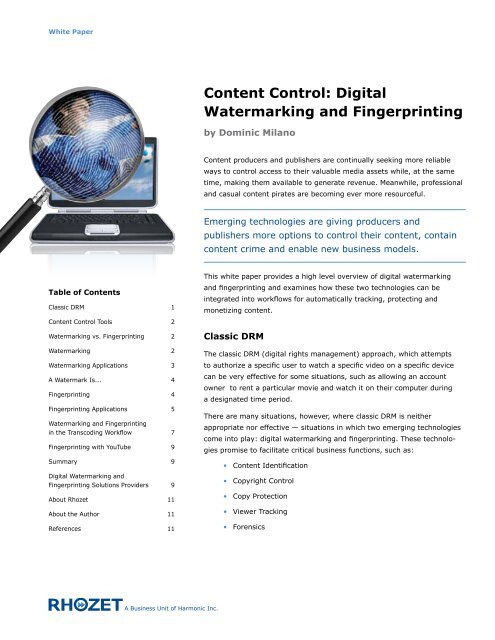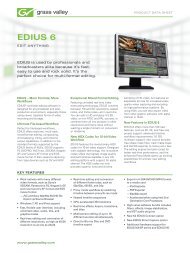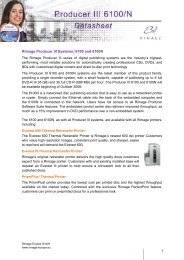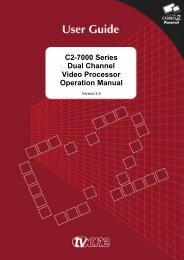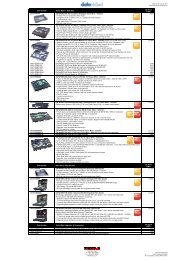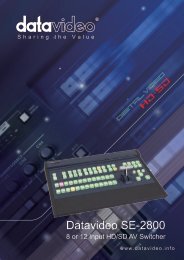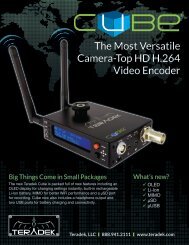Content Control: Digital Watermarking and Fingerprinting - Digimarc
Content Control: Digital Watermarking and Fingerprinting - Digimarc
Content Control: Digital Watermarking and Fingerprinting - Digimarc
You also want an ePaper? Increase the reach of your titles
YUMPU automatically turns print PDFs into web optimized ePapers that Google loves.
White Paper<br />
<strong>Content</strong> <strong>Control</strong>: <strong>Digital</strong><br />
<strong>Watermarking</strong> <strong>and</strong> <strong>Fingerprinting</strong><br />
by Dominic Milano<br />
<strong>Content</strong> producers <strong>and</strong> publishers are continually seeking more reliable<br />
ways to control access to their valuable media assets while, at the same<br />
time, making them available to generate revenue. Meanwhile, professional<br />
<strong>and</strong> casual content pirates are becoming ever more resourceful.<br />
Emerging technologies are giving producers <strong>and</strong><br />
publishers more options to control their content, contain<br />
content crime <strong>and</strong> enable new business models.<br />
This white paper provides a high level overview of digital watermarking<br />
Table of <strong>Content</strong>s<br />
Classic DRM 1<br />
<strong>and</strong> fingerprinting <strong>and</strong> examines how these two technologies can be<br />
integrated into workflows for automatically tracking, protecting <strong>and</strong><br />
monetizing content.<br />
<strong>Content</strong> <strong>Control</strong> Tools 2<br />
<strong>Watermarking</strong> vs. <strong>Fingerprinting</strong> 2<br />
<strong>Watermarking</strong> 2<br />
<strong>Watermarking</strong> Applications 3<br />
A Watermark Is... 4<br />
<strong>Fingerprinting</strong> 4<br />
<strong>Fingerprinting</strong> Applications 5<br />
<strong>Watermarking</strong> <strong>and</strong> <strong>Fingerprinting</strong><br />
in the Transcoding Workflow 7<br />
<strong>Fingerprinting</strong> with YouTube 9<br />
Summary 9<br />
<strong>Digital</strong> <strong>Watermarking</strong> <strong>and</strong><br />
<strong>Fingerprinting</strong> Solutions Providers 9<br />
About Rhozet 11<br />
About the Author 11<br />
References 11<br />
Classic DRM<br />
The classic DRM (digital rights management) approach, which attempts<br />
to authorize a specific user to watch a specific video on a specific device<br />
can be very effective for some situations, such as allowing an account<br />
owner to rent a particular movie <strong>and</strong> watch it on their computer during<br />
a designated time period.<br />
There are many situations, however, where classic DRM is neither<br />
appropriate nor effective — situations in which two emerging technologies<br />
come into play: digital watermarking <strong>and</strong> fingerprinting. These technologies<br />
promise to facilitate critical business functions, such as:<br />
• <strong>Content</strong> Identification<br />
• Copyright <strong>Control</strong><br />
• Copy Protection<br />
• Viewer Tracking<br />
• Forensics<br />
A Business Unit of Harmonic Inc.
White Paper: Video <strong>Watermarking</strong> <strong>and</strong> <strong>Fingerprinting</strong> Page 2<br />
<strong>Content</strong> <strong>Control</strong> Tools<br />
<strong>Watermarking</strong> versus <strong>Fingerprinting</strong>:<br />
What’s the Difference?<br />
Sometimes you will hear the terms “watermarking” <strong>and</strong> “fingerprinting”<br />
used interchangeably. While both the watermark <strong>and</strong> fingerprint uniquely<br />
identify a particular piece of video, they are very different in both purpose<br />
<strong>and</strong> execution.<br />
<strong>Watermarking</strong> <strong>and</strong> fingerprinting technologies<br />
offer media producers <strong>and</strong> publishers<br />
a promising set of tools for fighting<br />
content crime, as well as for a variety of<br />
other purposes.<br />
A watermark is like a tattoo, permanently<br />
added to every frame of the digital media<br />
file. Like a tattoo, a watermark may be<br />
visible (perceptible). Or, like a discretely<br />
placed tattoo that’s only apparent when<br />
clothing is removed, a watermark can be<br />
invisible (imperceptible).<br />
<strong>Fingerprinting</strong> digital media works very<br />
much like fingerprinting people, relying<br />
on innate characteristics of the subject.<br />
Human fingerprints are characterized by<br />
patterns of loops or whorls; digital media<br />
fingerprints are comprised of clues such<br />
as audio waveforms <strong>and</strong>/or video characteristics.<br />
In both cases, a database of<br />
fingerprints must be maintained, against<br />
which to compare fingerprints “found in<br />
the field,” <strong>and</strong> technology is needed to<br />
rapidly match fingerprint “evidence” to<br />
fingerprints on file.<br />
<strong>Watermarking</strong> adds information, embedding it within a<br />
video <strong>and</strong>/or audio signal.<br />
Many identical versions of the same piece of video can be created, each<br />
with its own unique watermark. If you sent those individually watermarked<br />
videos to 10 different people <strong>and</strong> one of them was illicitly uploaded to<br />
the web, the watermark would tell you which copy was posted <strong>and</strong> could,<br />
therefore, be traced back to the person responsible.<br />
<strong>Fingerprinting</strong> does not add any information — it analyses<br />
the media, identifying a unique set of inherent properties.<br />
Video fingerprints are stored in a database. Any video clip can be compared<br />
with fingerprints on file, to see if there is a match. Imagine that you<br />
are running a user-generated video website... You want users to be able to<br />
upload their own videos, but you don’t want to publish movies pirated from<br />
major content producers (for example Disney, HBO or CBS), because you<br />
don’t want to be sued. So when a user submits a video to your site, you<br />
generate its fingerprint <strong>and</strong> send it to a service that compares it to the fingerprints<br />
of thous<strong>and</strong>s of copyrighted movies on file. The service responds<br />
by telling you whether or not you should publish the video. And, of course,<br />
all of this is fully automated.<br />
<strong>Watermarking</strong><br />
Watermarks are useful for:<br />
• Tracking individual assets<br />
• Helping to identify who created a particular piece of content<br />
• Determining whether content was obtained by legitimate means<br />
Visible watermarks, such as network logos or station IDs in the lower third,<br />
are perceptible — useful as br<strong>and</strong>ing tools. <strong>Content</strong> protection, on the<br />
other h<strong>and</strong>, relies on invisible, or imperceptible watermarks, in which the<br />
original source file <strong>and</strong> its watermarked counterpart are visually indistinguishable<br />
from one another. You could make a hundred copies of the same<br />
video <strong>and</strong>, with imperceptible watermarks, uniquely identify each. Anyone<br />
A Business Unit of Harmonic Inc.
White Paper: Video <strong>Watermarking</strong> <strong>and</strong> <strong>Fingerprinting</strong> Page 3<br />
<strong>Watermarking</strong> Applications<br />
<strong>Content</strong> <strong>Control</strong>. The ability to trace the<br />
source of leaked classified information,<br />
proprietary corporate research or unauthorized<br />
copies of movies is one of the<br />
primary benefits that digital watermarking<br />
offers content owners. Companies are<br />
able to keep tabs on confidential recordings<br />
<strong>and</strong> videos. If something secret is<br />
leaked, the person responsible could be<br />
traced using digital watermarks.<br />
<strong>Digital</strong> watermarks can also be used to<br />
monitor distribution of sensitive material.<br />
For example, studios can use watermarks<br />
to track whomever has access to unreleased<br />
work prints <strong>and</strong> dailies. If someone<br />
makes <strong>and</strong> distributes illegal copies, they<br />
can be traced. During the Oscar season in<br />
Hollywood, for example, preview copies of<br />
new movies are individually watermarked<br />
before they are sent to voting members of<br />
the Academy of Motion Pictures. Anyone<br />
who leaks a movie can be prosecuted.<br />
<strong>Digital</strong> Cinema. Anti-piracy is a major<br />
concern for digital cinema. If films were<br />
sent to theaters in perfect digital form,<br />
they could be easily copied <strong>and</strong> illegally<br />
distributed. So digital watermarks identify<br />
each individual copy released, facilitating<br />
tracking <strong>and</strong> piracy prevention.<br />
<strong>Content</strong> Identification. By embedding<br />
watermarks in footage, content creators<br />
can identify the sources of specific content.<br />
For example, news organizations can<br />
determine whether footage retrieved from<br />
an archive came from a staff reporter, a<br />
freelancer or a third party.<br />
just viewing the videos would not be able to tell that they were different,<br />
but your watermarking system could identify each of them uniquely.<br />
So how do imperceptible watermarks work? All watermarking techniques<br />
are examples of steganography — the process of hiding secret messages<br />
in a document or picture so that only the sender <strong>and</strong> intended recipient<br />
know that the message even exists <strong>and</strong>, more importantly, know how<br />
to retrieve it. The classic example is the spy who sends a long letter to<br />
a “friend,” describing her travels. The document appears innocuous to<br />
anyone intercepting it. But the recipient knows that every 10th letter in<br />
the document spells out a secret message. Similarly, watermarking subtly<br />
modifies each image in a video so that no one can tell it has been altered.<br />
Just like the example of the letter, a very simple way to watermark images<br />
would be to either increase the brightness of every 100th pixel by a small<br />
amount or leave it alone, depending on whether we wanted to encode a<br />
“1” or a “0.” The recipient of our watermarked image could simply subtract<br />
the original image from the watermarked image <strong>and</strong> would be left with a<br />
series of grey dots on a black background. The grey dots would be our<br />
hidden binary message. This is an extremely simplified example; actual<br />
methods currently in use are much more complex.<br />
Watermarked Footage<br />
Original Footage<br />
Watermark Code<br />
Many current digital watermarking methods embed codes so that the<br />
image can be altered (transcoded, cropped, scaled, etc.) without losing<br />
the ability to extract the watermark. Plus current methods do not require<br />
that you have the original media for comparison, in order to extract the<br />
watermark data. Many techniques are similar to those used in compression<br />
technologies. The watermark ends up as very subtle color variations<br />
in the final image. If you don’t have the mathematical “key” revealing<br />
where the watermark data is hidden, you cannot find it.<br />
A complete discussion of the sophisticated mathematical methods that enable current<br />
watermarking techniques is beyond the scope of this document. For more information,<br />
please see the References listed on page 11.<br />
A Business Unit of Harmonic Inc.
White Paper: Video <strong>Watermarking</strong> <strong>and</strong> <strong>Fingerprinting</strong> Page 4<br />
A Watermark Is:<br />
• Data added to <strong>and</strong> often hidden<br />
within a media file<br />
• Usually a small amount of data,<br />
often just a unique identification<br />
number<br />
• Very hard to remove by distorting<br />
the image<br />
• Difficult to find if you don’t know<br />
the secret key<br />
• Typically the same data repeated<br />
in every video frame<br />
<strong>Watermarking</strong> systems <strong>and</strong> techniques are not generic or st<strong>and</strong>ardized —<br />
a watermark generated by one technology cannot be read by a system<br />
using a different technology. And even when two systems use the exact<br />
same technology, one customer would not be able to read another’s watermarks<br />
without the secret “key” that reveals where to find the watermark<br />
<strong>and</strong> how to decode it.<br />
Regardless of how complicated the math, the basic process of adding a<br />
watermark is fairly simple. The watermark is typically executed as a<br />
“filter” applied to an uncompressed video frame, resulting in an uncompressed<br />
frame that contains the embedded information. The watermarking<br />
filter must be programmed with the data to be embedded, as well as with<br />
the “key” that enables that data to be hidden.<br />
Data + Key Information<br />
Watermark Filter<br />
Raw Footage<br />
Watermarked Footage<br />
Since digital watermarking is usually performed on uncompressed frames,<br />
it is typically carried out as part of a transcoding process. The transcoder<br />
demultiplexes the video, decodes it into uncompressed frames, feeds the<br />
frames through the watermarking filter, then compresses the resulting<br />
frames <strong>and</strong> multiplexes them into the final format or formats.<br />
While there are some watermarking techniques that can be performed<br />
directly on compressed video, they are most often limited to maintaining<br />
the same compressed format (MPEG-2, for example).<br />
For a watermark to be useful, there must be a way to extract it <strong>and</strong> compare<br />
it with known watermarks. Some resources that provide watermarking<br />
technology also provide tracking services. They analyze content on the<br />
web <strong>and</strong> search for watermarked content. Other resources provide just<br />
the technology, assuming that only the customer will embed <strong>and</strong> detect<br />
watermarks. Your requirements <strong>and</strong> budget will dictate the type of watermarking<br />
you do.<br />
<strong>Fingerprinting</strong><br />
The purpose, value <strong>and</strong> execution of fingerprinting are quite different from<br />
those of watermarking. <strong>Watermarking</strong> relies on embedding information into<br />
the video <strong>and</strong>/or audio, then uses that information to identify the piece of<br />
content. <strong>Fingerprinting</strong> does not embed any information; it analyzes the<br />
A Business Unit of Harmonic Inc.
White Paper: Video <strong>Watermarking</strong> <strong>and</strong> <strong>Fingerprinting</strong> Page 5<br />
<strong>Fingerprinting</strong> Applications<br />
Broadcast <strong>and</strong> General Media<br />
Monitoring. Fingerprints can be used to<br />
track when <strong>and</strong> where a video has been<br />
shown. This capability will be useful to<br />
advertising agencies <strong>and</strong> their clients<br />
who want to monitor their media activities.<br />
<strong>Content</strong> syndicators will use it to<br />
track when <strong>and</strong> where programming<br />
has appeared. Talent agencies will use<br />
it to monitor activities for which their<br />
clients are owed performance royalties.<br />
Organizations such as the AP <strong>and</strong> Reuters<br />
will monitor how their content is being<br />
used by broadcast <strong>and</strong> online news operations,<br />
as well as bloggers.<br />
Copyright <strong>Control</strong>. Cross-referencing<br />
actual usage rights <strong>and</strong> permissions in a<br />
fingerprint database will facilitate monitoring<br />
of authorized <strong>and</strong> unauthorized uses<br />
of content. <strong>Content</strong> producers <strong>and</strong> distributors<br />
will use fingerprints to determine<br />
whether a database contains unauthorized<br />
content. Stock footage providers will use<br />
fingerprints to spot the clips they license<br />
in commercial programming.<br />
Metadata. Metadata allows content<br />
creators to store all sorts of useful tracking<br />
information associated with content.<br />
For example, metadata can be used to<br />
supplement video fingerprints by storing<br />
vital information about users (such as who<br />
created the content <strong>and</strong> who has modified<br />
it), a history of use, which operating systems<br />
a video has been played on <strong>and</strong> by<br />
what version of which player technology,<br />
information about which networks content<br />
has traveled on <strong>and</strong> more. This information<br />
will be invaluable during forensic<br />
investigations to trace pirating operations,<br />
uncover traitors within organizations<br />
<strong>and</strong> so on.<br />
video <strong>and</strong>/or audio to determine the unique characteristics of the content.<br />
The identified pattern is stored in a database <strong>and</strong> can be used for recognizing<br />
the content in the future.<br />
The graphic below represents the audio waveform for a specific piece<br />
of music.<br />
A fingerprinting system needs to create a database that can be used to<br />
identify an exact piece of content, should the system ever encounter the<br />
same piece of content again. One way of doing that would be to store the<br />
entire piece of music in the database <strong>and</strong> then compare every new piece<br />
encountered with the entire original. This would work, but it would be<br />
slow, <strong>and</strong> the database would become very large. Imagine doing the same<br />
thing with video — the database would be unmanageably large! So instead<br />
of storing the entire piece of audio, only a statistical sample is stored.<br />
For example, four samples could be taken every 10th of a second, as<br />
shown below.<br />
A B C D E F G H I J K L<br />
Gracenote’s TuneUp Companion for iTunes<br />
is one of the first applications to combine<br />
metadata with fingerprinting. The application’s<br />
primary use is to clean up metadata<br />
associated with recorded music. It will<br />
also be used to retrieve album cover art,<br />
tour schedules, YouTube videos, news<br />
about recording artists <strong>and</strong> more.<br />
A Business Unit of Harmonic Inc.
White Paper: Video <strong>Watermarking</strong> <strong>and</strong> <strong>Fingerprinting</strong> Page 6<br />
<strong>Fingerprinting</strong> Applications<br />
Behavioral Modeling Advertising.<br />
Interest-based or behavioral advertising<br />
matches ads to individuals based on a<br />
user’s past online activities, such as visiting<br />
a website or searching for information<br />
on a particular subject. Video fingerprinting<br />
extends that capability to marketers<br />
who want to reach consumers based<br />
on their video viewing interests. It also<br />
brings behavioral advertising models to<br />
new domains, such as VOD services <strong>and</strong><br />
cable television where signals must pass<br />
through a set-top box.<br />
Copy Protection. Video fingerprints can<br />
be used as a copy protection tool. For<br />
example, both a video fingerprint <strong>and</strong> an<br />
authenticating signature could be required<br />
before a file could be copied or replicated.<br />
Forensics. Another promise of video<br />
fingerprinting is in the area of information<br />
forensics where fingerprints could be used<br />
to detect whether video footage has<br />
been manipulated. Research is ongoing<br />
in this area.<br />
Now imagine that sampling continues in this manner through the entire<br />
audio waveform. If the source file is a two-minute song, there would be<br />
over 4,000 samples in the fingerprint, but the actual fingerprint file would<br />
still be a thous<strong>and</strong> times smaller than the original audio file. Why is it so<br />
small? The original audio might have had a sampling frequency of 48kHz<br />
(a common st<strong>and</strong>ard), which means 48,000 samples per second. The<br />
fingerprint is only being sampled 40 times each second (four samples<br />
every 1/10th of a second), which means there is a thous<strong>and</strong> times less<br />
data. These samples comprise a unique signature that corresponds to the<br />
specific piece of music. Any other piece of music would have a different<br />
pattern of samples. Just as a criminal’s fingerprints don’t tell the police<br />
what he looks like, the samples don’t really indicate what the music<br />
sounds like. They just allow it to be uniquely identified.<br />
The example above is merely a simplified example of how audio fingerprinting<br />
might work. Modern fingerprinting algorithms actually sample<br />
a wide variety of audio <strong>and</strong>/or video characteristics to produce the<br />
fingerprint. To thwart pirates, sophisticated techniques are used to hide<br />
the exact nature of the properties on which fingerprints are based.<br />
For example, r<strong>and</strong>om temporal <strong>and</strong> spatial sampling is used to hide<br />
information about which properties are used to produce the fingerprint.<br />
A fingerprint is generated from a series of uncompressed frames. The<br />
fingerprint can incorporate metadata about the media, along with the<br />
fingerprint pattern.<br />
Additional Business Opportunities.<br />
<strong>Digital</strong> fingerprints must be matched<br />
against extensive content ownership<br />
databases to be effective. It st<strong>and</strong>s to<br />
reason that maintaining, licensing <strong>and</strong><br />
managing access to large-scale fingerprint<br />
databases is a potential revenue<br />
opportunity. Audible Magic, for example,<br />
has already established a subscriptionbased<br />
business leveraging its extensive<br />
ownership database.<br />
Raw Footage<br />
Metadata<br />
Fingerprint Exporter<br />
Metadata<br />
Fingerprint<br />
Unlike watermarking, where application of the watermark filter produces<br />
a file of uncompressed video frames (which still yields a relatively large<br />
file even after compression), the fingerprint exporter does not generate a<br />
viewable media file at all — it creates a much smaller fingerprint file,<br />
documenting inherent characteristics of the media content.<br />
Video fingerprints are resolution <strong>and</strong> format independent. They can be<br />
used to identify complete videos, portions of videos <strong>and</strong>, more important,<br />
very short snippets of videos. Fingerprints can even be used to spot video<br />
content that has been manipulated, as it might be if included in a video<br />
mash up.<br />
A Business Unit of Harmonic Inc.
White Paper: Video <strong>Watermarking</strong> <strong>and</strong> <strong>Fingerprinting</strong> Page 7<br />
A Fingerprint Is:<br />
• Not a media file — cannot be viewed<br />
as video or listened to as audio<br />
• A very small data file<br />
• Comprised of a pattern of inherent<br />
characteristics representing specific<br />
media content<br />
• Resolution <strong>and</strong> format independent<br />
• Stored in a database that can be<br />
used to match <strong>and</strong> identify specific<br />
content, even if the content has<br />
been altered<br />
One of the ways pirates steal films is by secreting a video camera into<br />
a theater <strong>and</strong> illegally taping the movie. Video fingerprints cannot be<br />
defeated in this manner.<br />
Audio fingerprints, unfortunately, aren’t as resistant to manipulation as<br />
video fingerprints. It’s relatively easy to alter or completely replace audio<br />
tracks. For example, completely new soundtracks usually accompany video<br />
mash ups, or pirated films might be shown in foreign countries with new<br />
dialogue tracks. So identifying content based solely on an audio fingerprint<br />
can be problematic.<br />
<strong>Watermarking</strong> <strong>and</strong> <strong>Fingerprinting</strong> in the<br />
Transcoding Workflow<br />
When you add the enormous accumulation of video content that resides in<br />
the archives of media organizations to all of the new content that’s constantly<br />
being produced, you realize that sheer volume poses a significant<br />
challenge to utilizing both watermarking <strong>and</strong> fingerprinting technologies.<br />
At the very minimum, implementing an anti-piracy solution around watermarking<br />
requires the following capabilities:<br />
• Method to embed watermarks<br />
• Database to track watermarks<br />
• Method to detect watermarks<br />
For watermarking, consider whether to h<strong>and</strong>le detection in-house or<br />
whether to employ an outside service. The choice depends on how the<br />
watermark will be used. For example, to trace a single video back to its<br />
source should it be leaked, detection could be easily h<strong>and</strong>led in-house.<br />
If your preference is to let someone else hunt down leaks, perhaps<br />
because they could come from a large number of would-be pirates,<br />
consider an external detection service.<br />
<strong>Fingerprinting</strong> requires the following capabilities:<br />
• Method to generate fingerprints<br />
• Database to store metadata relating fingerprints to originals<br />
• Third-party service (or multiple services) that tracks fingerprints<br />
<strong>and</strong> provides access control information<br />
One of the problems with current watermarking <strong>and</strong> fingerprinting technologies<br />
is that they only accept a limited number of input formats. And,<br />
in the case of watermarking, they only generate a limited set of output<br />
formats. This is where Rhozet <strong>and</strong> transcoding come into the picture.<br />
Rhozet Carbon Coder is a general-purpose transcoder that h<strong>and</strong>les<br />
dozens of different format types. Plugging a particular watermarking or fingerprinting<br />
technology into Carbon Coder allows you to h<strong>and</strong>le any media<br />
type. Carbon Coder can be run as a st<strong>and</strong>-alone transcoding engine or as<br />
part of a larger transcoding farm for higher volume workflows.<br />
A Business Unit of Harmonic Inc.
White Paper: Video <strong>Watermarking</strong> <strong>and</strong> <strong>Fingerprinting</strong> Page 8<br />
Transcoding a media file from one video format to another involves a<br />
number of steps:<br />
• Demultiplex the original into its constituent audio <strong>and</strong> video<br />
components<br />
• Decode the audio <strong>and</strong> video using the appropriate codecs<br />
• Transform the audio <strong>and</strong> video (e.g., frame size, frame rate,<br />
graphic overlays, filters, etc.)<br />
• Encode the audio <strong>and</strong> video with the target codecs<br />
• Multiplex the audio <strong>and</strong> video into the final wrapper (e.g., MPEG-2<br />
Transport Stream)<br />
For the fastest execution, all of this occurs on-the-fly, in memory.<br />
In watermarking, the watermarking filter is plugged into the Carbon Coder<br />
pipeline <strong>and</strong> is applied during the transform stage. The result is a media<br />
file, in whatever format is required for distribution.<br />
Watermark Filter<br />
Video<br />
Decode<br />
Video<br />
Transform<br />
Video<br />
Encode<br />
Demultiplex<br />
Multiplex<br />
Audio<br />
Decode<br />
Audio<br />
Transform<br />
Audio<br />
Encode<br />
Watermarked<br />
Video File<br />
In fingerprinting, the fingerprint technology is embedded into Carbon<br />
Coder as an exporter. It analyzes the uncompressed audio <strong>and</strong> video<br />
frames <strong>and</strong> generates a fingerprint file, which can be used to recognize<br />
the original media, in whatever format it is found. (There are no<br />
transform, encode or multiplex steps, because the output is only a<br />
fingerprint; not a media file.)<br />
Video<br />
Decode<br />
Demultiplex<br />
Audio<br />
Decode<br />
Fingerprint<br />
Exporter<br />
Fingerprint<br />
A Business Unit of Harmonic Inc.
White Paper: Video <strong>Watermarking</strong> <strong>and</strong> <strong>Fingerprinting</strong> Page 9<br />
<strong>Fingerprinting</strong> with YouTube<br />
Google has created a sophisticated mechanism<br />
for helping to control piracy on<br />
the YouTube video sharing site. YouTube<br />
allows content owners to fingerprint<br />
their original media <strong>and</strong> then upload the<br />
fingerprints to YouTube’s central database.<br />
Every video that is uploaded to YouTube is<br />
first compared with the central fingerprint<br />
database, before it is displayed.<br />
The content owner can specify usage<br />
policies that govern how YouTube should<br />
h<strong>and</strong>le matched content, including monetization<br />
<strong>and</strong> blocking. This means that a<br />
content owner can share in the advertising<br />
revenue from his video, regardless of<br />
who actually uploaded it.<br />
If someone uploads a piece of content<br />
that its original owner requested be<br />
blocked, then YouTube will not allow this<br />
video to be shown. This is an extremely<br />
effective way to prevent piracy. Rather<br />
than having to request the removal of<br />
content after it has been posted (which<br />
is like shutting the barn door after the<br />
horse has left), this technique actually<br />
prevents the video from being posted<br />
in the first place.<br />
Google <strong>and</strong> Rhozet have integrated the<br />
YouTube fingerprint creation software right<br />
into Carbon Coder software. This free-ofcharge<br />
component allows content owners<br />
to create fingerprints as part of their<br />
st<strong>and</strong>ard workflows. Thus fingerprinting<br />
can happen much earlier in the production<br />
pipeline. For example, a customer could<br />
fingerprint dailies of a movie 18 months<br />
before its release, in order to guarantee<br />
that no leaks get shown on YouTube.<br />
YouTube fingerprinting is unique to the<br />
YouTube website. Blocking something on<br />
YouTube does not make it automatically<br />
blocked on some other site. But since<br />
YouTube accounts for approximately<br />
40% of all video viewed on the web,<br />
it is a crucial component in the fight<br />
against piracy.<br />
Many watermarking <strong>and</strong> fingerprinting companies are now integrating<br />
their technology with Rhozet transcoding systems to take advantage of the<br />
Rhozet transcoding workflow. You can actually have multiple technologies<br />
from different vendors all plugged into the same Carbon Coder system.<br />
This allows you to use a single transcoding network to create <strong>and</strong> detect<br />
a variety of watermarks <strong>and</strong> fingerprints.<br />
Summary<br />
<strong>Watermarking</strong> <strong>and</strong> fingerprinting are exciting technologies that can facilitate<br />
critical business functions, including content identification, copyright<br />
control, behavior tracking, copy protection <strong>and</strong> forensics. In addition,<br />
these technologies provide the means for content owners who embrace<br />
emerging distribution platforms, such as user generated content websites,<br />
to develop new revenue models based on what they previously might have<br />
considered pirated content.<br />
Rhozet Carbon technology streamlines transcoding<br />
workflows <strong>and</strong> seamlessly integrates with a variety of<br />
watermarking <strong>and</strong> fingerprinting solutions.<br />
Rhozet does not sell these anti-piracy technologies, instead partnering<br />
with their developers to allow them to be integrated into Rhozet<br />
transcoding solutions.<br />
<strong>Watermarking</strong> <strong>and</strong> <strong>Fingerprinting</strong><br />
Solutions Providers<br />
Audible Magic<br />
http://www.audiblemagic.com/products-services/contentsvcs/<br />
Audible Magic provides sophisticated content identification services that allow content<br />
owners to track <strong>and</strong> manage their copyrighted work in electronic form. Using<br />
patented CopySense identification techniques, the service recognizes content<br />
based on digital fingerprints. The approach is highly accurate <strong>and</strong> does not rely on<br />
metadata, watermarks or file hashes. The technology is immune to compression<br />
<strong>and</strong> distortion as well as codec choice, file type <strong>and</strong> streaming format. An efficient<br />
<strong>and</strong> compact API library facilitates easy implementation of CopySense technology.<br />
Audible Magic maintains a growing ownership database that currently includes<br />
over 6 million works.<br />
Civolution<br />
http://www.civolution.com/<br />
Civolution offers an extensive portfolio of digital fingerprinting <strong>and</strong> watermarking<br />
technology solutions for IP licensing, Pay TV, forensic tracking <strong>and</strong> digital<br />
cinema applications. Civolution uses fingerprinting technology to automatically<br />
A Business Unit of Harmonic Inc.
White Paper: Video <strong>Watermarking</strong> <strong>and</strong> <strong>Fingerprinting</strong> Page 10<br />
identify multimedia content. Fingerprints are extracted <strong>and</strong> stored in a database.<br />
<strong>Content</strong> fingerprints are matched against the contents of the database. Civolution<br />
watermarking technology embeds a unique, imperceptible watermark into video<br />
or audio material that can be used by content owners to identify <strong>and</strong> track their<br />
material. Civolution video watermarking technology was used to identify the<br />
source of illegal copies of the 2003, 2004 <strong>and</strong> 2005 Academy Award Screeners.<br />
Fraunhofer<br />
http://www.sit.fraunhofer.de/EN/forschungsbereich/tad/index.jsp<br />
The Fraunhofer Institute for Secure Information Technology SIT researches,<br />
develops <strong>and</strong> deploys security solutions for IT environments. Along with a number<br />
of related initiatives, their Transaction <strong>and</strong> Document Security department is<br />
engaged in digital watermarking <strong>and</strong> cryptography. Fraunhofer is responsible for<br />
developing the MP3 codec.<br />
YouTube<br />
http://www.youtube.com/t/video_id_about?gl=GB&hl=en-GB<br />
YouTube Video Identification, developed in conjunction with Google, uses video<br />
fingerprinting to recognize content by comparing its fingerprint against a fingerprint<br />
database. YouTube/Google can create the fingerprint when video is submitted<br />
to YouTube.com, or content creators can create a fingerprint independently<br />
<strong>and</strong> submit just the fingerprint to YouTube’s fingerprint database. <strong>Content</strong> owners<br />
are able to specify rights <strong>and</strong> permissions that govern the use of their content,<br />
whether they themselves submit it to YouTube or users upload it. <strong>Content</strong> owners<br />
can block or promote their content or even derive revenue from it regardless of<br />
whether it was uploaded “officially” or by users.<br />
Thomson<br />
http://www.thomson.net/GlobalEnglish/Innovation/Innovation_centers/<br />
tracking%20<strong>and</strong>-security-technologies/Pages/default.aspx<br />
Thomson NexGuard watermarking adds an imperceptible <strong>and</strong> indelible code to<br />
video sequences. When NexGuard is used in conjunction with Sapphire VOD servers,<br />
a unique watermark is generated each time content is requested, allowing the<br />
content to be tracked forensically to determine the source of illegally copied <strong>and</strong><br />
distributed content. NexGuard has been implemented by studios, post-production<br />
facilities <strong>and</strong> in digital cinema environments as well as in set-top boxes, satellite<br />
<strong>and</strong> IPTV applications.<br />
Vobile<br />
http://www.vobileinc.com/technology.html<br />
The Vobile <strong>Content</strong> Identification Platform is based on patented VideoDNA<br />
fingerprinting technology that is used to extract a fingerprint without altering the<br />
source content. Identifying an unknown video involves extracting its VideoDNA<br />
(a fingerprint) <strong>and</strong> matching it against entries in the Vobile <strong>Content</strong> Registry<br />
(a fingerprint database). The Vobile <strong>Content</strong> Identification Platform supports a<br />
variety of applications including media rights management, targeted advertising,<br />
business intelligence, metadata services, asset management <strong>and</strong> video search <strong>and</strong><br />
categorization.<br />
A Business Unit of Harmonic Inc.
White Paper: Video <strong>Watermarking</strong> <strong>and</strong> <strong>Fingerprinting</strong> Page 11<br />
About Rhozet<br />
Since 2004, Rhozet, a business unit<br />
of Harmonic Inc, has focused on<br />
designing scalable, high-performance,<br />
universal media transcoding technology<br />
for delivering content in any<br />
format, at any time, on any device,<br />
smoothly, efficiently <strong>and</strong> in the most<br />
cost-effective manner possible.<br />
Rhozet began as part of Canopus<br />
<strong>and</strong> operated as an independent<br />
company from 2005 until August<br />
2007, when Rhozet was acquired<br />
by Harmonic, a manufacturer of<br />
enterprise-class hardware encoders.<br />
In addition to its enterprise transcoding<br />
products, Carbon Coder <strong>and</strong><br />
Carbon Server, Rhozet is the developer<br />
of the popular desktop transcoding<br />
applications ProCoder <strong>and</strong> ProCoder<br />
Express, which have been marketed<br />
<strong>and</strong> sold under the Grass Valley br<strong>and</strong><br />
since its acquisition of Canopus.<br />
About the Author<br />
Dominic Milano is the principal of<br />
DM&C, a company that provides content<br />
creation <strong>and</strong> consulting services<br />
in a variety of markets, including<br />
video, music <strong>and</strong> sound design, game<br />
development, interactive design, 3D<br />
modeling <strong>and</strong> animation <strong>and</strong> related<br />
creative fields. Dominic has over 30<br />
years of experience in print, online<br />
<strong>and</strong> event media production, working<br />
on DV magazine, DV.com, DV<br />
Expo, Game Developer magazine <strong>and</strong><br />
the Game Developer Conference,<br />
Keyboard magazine, Guitar Player<br />
magazine <strong>and</strong> more.<br />
References<br />
<strong>Digital</strong> <strong>Watermarking</strong><br />
http://en.wikipedia.org/wiki/<strong>Digital</strong>_watermarking<br />
<strong>Digital</strong> <strong>Watermarking</strong> Alliance<br />
http://www.digitalwatermarkingalliance.org/<br />
<strong>Digital</strong> Video <strong>Fingerprinting</strong><br />
http://en.wikipedia.org/wiki/<strong>Digital</strong>_video_fingerprinting<br />
Forensics<br />
http://www.csl.uiuc.edu/research/info_foren1.asp<br />
New Applications for Music <strong>Fingerprinting</strong><br />
http://www.drmwatch.com/watermarking/article.php/3759456<br />
IBM Developer Works<br />
http://www.ibm.com/developerworks/power/library/pa-soc11/index.html<br />
Collusion-Secure <strong>Fingerprinting</strong> for <strong>Digital</strong> Data<br />
http://citeseerx.ist.psu.edu/viewdoc/summary?doi=10.1.1.40.2227<br />
Video <strong>Fingerprinting</strong> Based on Centroids of Gradient Orientations<br />
http://ieeexplore.ieee.org/xpl/freeabs_all.jsp?tp=&arnumber=1660364&is<br />
number=34758<br />
Collusion-Resistant <strong>Fingerprinting</strong> for<br />
Compressed Multimedia Signals<br />
Exploring QIM based Anti-Collusion <strong>Fingerprinting</strong> for Multimedia<br />
http://www.ece.umd.edu/~ashwins/fingerprinting.html<br />
Collusion-Resistant Video <strong>Fingerprinting</strong> for Large User Group<br />
www-video.eecs.berkeley.edu/Proceedings/ICIP2006/pdfs/0002301.pdf<br />
History of Steganography <strong>and</strong> Cryptography<br />
http://www.petitcolas.net/fabien/steganography/history.html<br />
Robust Video <strong>Watermarking</strong> of H.264/AVC<br />
http://ieeexplore.ieee.org/xpl/freeabs_all.jsp?arnumber=4100886<br />
A Novel Scheme for Hybrid <strong>Digital</strong> Video <strong>Watermarking</strong>:<br />
Approach, Evaluation <strong>and</strong> Experimentation<br />
http://ieeexplore.ieee.org/Xplore/loginjsp?url=http%3A%2F%2Fieeexplore<br />
.ieee.org%2Fiel5%2F76%2F32993%2F01546010.pdf%3Farnumber%3D15<br />
46010&authDecision=-203<br />
A Business Unit of Harmonic Inc.


